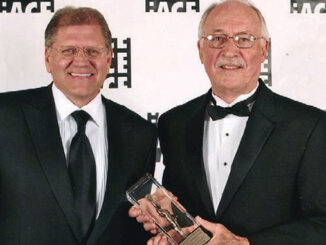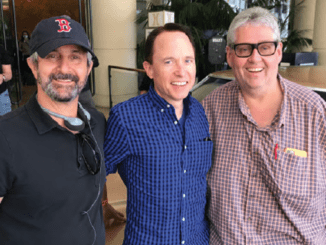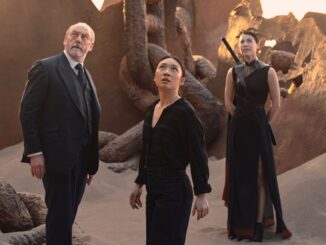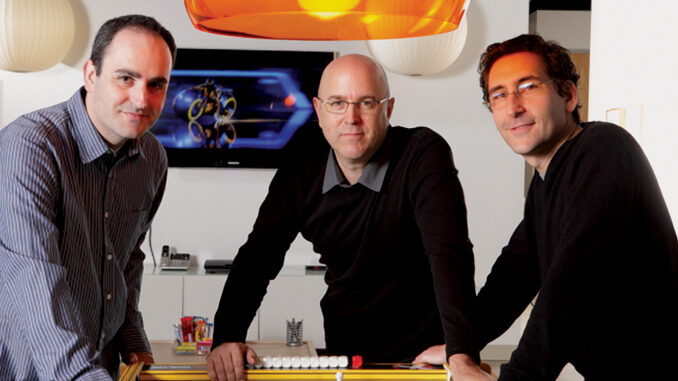
by Garrett Gilchrist • portraits by Gregory Schwartz
In the summer of 1982, Disney and director Steven Lisberger introduced TRON, a landmark special effects film that took us into a dangerous, groundbreaking computer world. Computer graphics were in their infancy, and nearly every frame also featured hand-drawn and rotoscoped ani- mated effects. The film was ahead of its time, and some audiences didn’t know what to make of it.
Things have certainly changed. TRON: Legacy, which opened December 17, is a $170-million 3-D visual effects thrill ride––as cutting edge in its technology and design as the orig- inal was in its time. Garrett Hedlund and Olivia Wilde star alongside Jeff Bridges, who returns 28 years later as Kevin Flynn, and also as his eerily lifelike, younger, computer-gener- ated alter ego. Director Joseph Kosinski was an architect who began building intricate virtual worlds, then made his name directing award-winning commercials full of CGI effects. This is his first feature film, and it seems a natural fit.
Also a natural choice for this stylish, effects-filled film is James Haygood, A.C.E., who edited Fight Club, Panic Room and The Game for David Fincher, and co-edited (with Eric Zumbrunnen) Where the Wild Things Are for Spike Jonze. Editors Guild Magazine recently spoke to Haygood, as well as visual effects editor Andrew Loschin and first assistant editor Dylan Firshein, about this challenging project while they were still working on the film.

Editors Guild Magazine: What did you think of the original TRON?
James Haygood: The original TRON is an iconic cult film that’s seeped into popular culture, but most people haven’t actually seen it. I had to watch it again myself, because I only remembered moments. They put an incredible amount of work into it. It’s really an old-school, cel-animated film combined with early computer-generated images. Those great designs by Syd Mead, Moebius and the team are still beautiful––and that’s a lot of what drew Joe Kosinski in; he felt he could update that. There’s a lot to work with in the world Lisberger created. So Joe imagined this server that’s been disconnected from the outside world for 30 years, and has grown on its own terms.
EGM: How finished was the material you were editing?
JH: [laughing] It won’t be finished until hours before it’s screened for the press! We’ve been working with blue screen shots, and with very rough, temporary, cartoony previz. We’d see concept art and have a general idea of what’s in the background, but a lot of it was in Joe’s head. So I worked with the fundamentals of the story and dialogue and judged it on those terms, making the performances work. All the visuals that come later are just gravy that makes it better. As shots come in, we say, “Oh! So that’s what that looks like!” I have a general idea what’s to come, enough to con- struct the scene, but it’s eye-opening to see what’s really going on. The final comps are this immersive environment with all this depth and nuance.
EGM: How involved has TRON director Steven Lisberger been in this new ver- sion?
JH: He’s been around since the script stage, as they were conceiving the story. He gives us his comments, but he respects Joe and doesn’t interfere. He’s the voice that connects us to the original film, the soul of the project.
EGM: You met director Joseph Kosinski through David Fincher.
JH: I think David saw something familiar in Joe––his attention to detail, his compositional clarity of vision. They have a lot of similarities, but very different sensibilities. As an editor, you’re so dependent on connecting with a director, someone with whom you can go on this ride. I was lucky to have met Joe at the beginning of his career, as I was lucky to meet David at the beginning of his. Luck is very important in this business.
Joe came in so full of confidence, vision and potential. What he’s done on TRON: Legacy is a miracle––pulling off a huge, complicated, 3-D visual effects film with a very tight shooting schedule. I worked with David in the very beginning, and he was just born to direct films, to be in the film business…like he’d been wait- ing to be of legal age so he could start. Joe has a bit of that too. They both have the confidence and the willpower to inspire confidence in other people, so they’ll open their checkbooks or commit their talents and time. It’s not just about directing; it’s the whole package to get a project off the ground. And Joe has that.
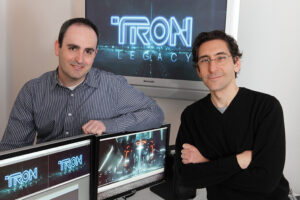
EGM: On a special effects film, you have to lock the picture pretty early, don’t you?
JH: There’s a six-to-nine-month lead time on these effects shots, a very long process. So you have to commit, and you lose editorial flexibility very early. It can be frustrating. Any changes you make later in the process cost money. It was a massive job; there were about 1,600 shots to finish and supervise, while at the same time pushing the envelope of technology. Any changes wreak havoc.
EGM: A younger Jeff Bridges was created!
JH: That’s a really high bar, re-creating a well-known human being. It’s not some imaginary character. People know what Jeff Bridges looked like. It’s new technology, a really labor-intensive process.
For many years, filmmaking was a static thing. Now, every project is a new challenge, and you adapt. We’re dealing with 3-D, the visual workflow, setting things up and getting material to visual effects vendors.
Dylan Firshein: We’re really fortunate that the 3-D workflow was set up in a smart way from the start. We shot with the Pace Fusion rig, which was used on Avatar. Dave Wattro from Pace did an amazing job, along with data managers Javier Marcheselli and Maja Zdanowski. Almost everything “filmed” went directly to them, and they processed the footage and checked that the 3-D metadata was correct. When complete, they would archive the footage to LTO [Linear Tape- Open] tapes. Each LTO tape was treated as original camera negative and housed for later visual effects pulls and the final conform.
Pace provided us with Avid bins and media, which included a single-eye clip as well as a fused side-by-side stereo clip. Although the production shot in Vancouver, we were cutting in LA, so the dailies––often over 100 gigabytes a day––were delivered via Aspera to Disney.
Additionally, we had some high-speed material shot on the Phantom camera and motion-capture footage. Throughout post, we worked in a shared project on Unity, running Avid Media Composer 3.5, with up to five Avids total. For a show of this size, we had a very small crew, so it kept us really busy.
Andrew Loschin: Jim often watched the dailies in 3-D on the Avid to get a sense of what Joe was going for, but we largely cut in 2-D because this film is so visual effects-heavy. With our small crew, it would have been difficult to do the number of temp comps we did to help tell the story, and to have to worry about them being in 3-D as well.
DF: Also, our director was very critical about resolution. Between the 3-D monitor and a compressed fused image, we found that having the full 1920 x 1080 image was more important.
JH: Since the production was so careful and conservative about how the 3-D was photographed, Joe and I ignored the 3-D, for the most part, while we were editing. We just edited the film in a normal way. Because of the tight shooting schedule, and dealing with 3-D and lightsuits on the actors, as well as other complications on the set, there wasn’t too much coverage. They also had to film many scenes twice, with Jeff Bridges performing his role as Clu, and then a body double running through the scene as his younger self. So we didn’t have a million shots to cut to, and that enforced a restrained style to the cutting, which we figured would serve the 3-D very well.
EGM: Was the 3- D your biggest challenge on this film?
AL: It was quite challenging during our initial setup and visual effects turnovers, but some of the more daunting challenges were the other new things that were thrown our way, including motion-capture footage, head-cam footage, witness cameras and an array of Red cameras that were shot for one sequence. We made sure all of these different elements were brought into the Avid in a way that we could simply track back to the source when it was time to pull them as part of visual effects turnovers.

We also wanted to keep these elements as organized and simple as possible so Jim and Joe could quickly go through and choose the pieces they wanted, like with any other dailies. This meant a lot of work up-front for me, in manually logging and batch-importing to actually have the correct time code and tape name as part of the Avid metadata. But it helped significantly when we turned over our visual effects shots.
DF: Getting the 3-D shots back didn’t change the cut much. The only times we adjusted cut points, based on the 3-D, is when elements were quickly coming at the screen. I’d heard that when James Cameron made Avatar, he wanted a film that people could enjoy in 2-D. That was our goal as well.
JH: Editing TRON: Legacy was challenging, like every movie is challenging. Once we had the footage in the Avid, it was like any other show. You see what material you have and you try to tell the story. In a sense, it’s more focused. You really focus on the performances, because you don’t have the full environments until the effects are done.
Another benefit when working on a blue-screen film is that for re-shoots, all that was needed was a blue screen and a little bit of set, or none at all. We could be very surgical and precise about what we shot, and we could drop a couple new lines right into the middle of a scene. Normally, you’d need to return to a location or rebuild some big set, but we could pick up pieces of a bunch of scenes in just a day or two of shooting against blue. That was pretty cool, and made significant improvements to the film.
EGM: How did you approach editing on such an effects-heavy film?
JH: I tried not to be distracted by the technology and just focus on this father and son story. There were entire departments around the world taking care of the visual effects. I was the keeper of the story. I’m always in awe reading some- one like Walter Murch, who is so bright and intellectual about the process, with a wealth of references and reasons why he does what he does, because I’m not like that. That’s not my skillset.
My approach to editing is instinctual. You respond to the material and the rhythms and what feels real and natural, and hope that subtext and rhythmic subtlety, everything you could be more intellectual about, just happens in an organic way.
EGM: You co-edited Where the Wild Things Are for Spike Jonze in a powerful story about childhood. What was it like working with him?
JH: Spike is like a child. He still has that very much alive in him. He jumps on furniture, skateboards in the office, wrestles with people, draws tattoos on them with Sharpies. He’s in touch with that innocence and anxiety about growing up in a world you don’t understand.
TRON: Legacy and Wild Things could- n’t be more different; TRON is stark, clean and minimalist, while Wild Things is brown, organic and messy. The visual effects people on set must have been medicated. Spike was running around with several cameras running, throwing dust and leaves in the air––everything a visual effects crew wouldn’t want. Several effects people went by the way- side; they really couldn’t handle it. Fortunately, we built a group who saw the opportunity to work in Spike’s creative world and create something different. It was never going to be technically perfect, but maybe it was going to be more alive. I just have a lot of affection for that project––the story and the characters. I real- ly thought it was beautiful.
EGM: David Fincher, with whom you’ve worked several times, is a pioneer in using CGI.
JH: He’s always experimenting, talking to people who are dialed into new technology, seeing what’s possible. He learns about new tools, and then finds a place in the script to use them––and to push the limits. Effects companies all want to work with David, knowing that they’re not going to make much money, but they’re going to do what hasn’t been done before. Hopefully it works out for every- one in the end.
He shoots for editing and he gives you the pieces you need. I’ve worked on some films where my contribution was greater, because I had to raise the material to a higher level when it wasn’t that great. With David, you’re surrounded by great material, great performances, great innovations. It makes the job much easier.
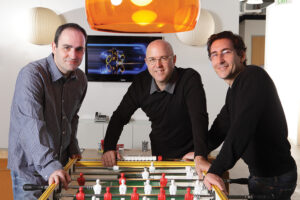
EGM: You were an additional editor on Eternal Sunshine of the Spotless Mind for Michel Gondry.
JH: That was really fun. I came on to help for a few months. After reading the script, I’d do anything to be involved. Michel was always thinking. He’d go into his office, draw these crazy R. Crumb animations on binder paper, and shoot them with his 16mm camera on his desk lit with a desk lamp. He’d process the film in a plastic bucket in the closet, and come out with a strip of film, dripping. He’d hand it to the assistants and say, “Get this transferred!” He’d have his synthesizer in the cutting room, making sound effects. He’s so fun and imaginative––this mad genius figuring out ways to do these intricate things, like in his videos. He’s one of the most talented people that way. You realize it’s a simple elegant solution but it looks incomprehensibly complicated.
EGM: What, to you, is a well-edited film?
JH: If I see a film and enjoy the performances, I believe the editor’s done a good job. The fun part of my job is manipulating these raw performances–– these fragments––all in pieces. As an editor, you have to find the reality of the movie beyond what the intention was when it was written and shot: What’s working well, and what isn’t? This is taking too long, I don’t understand this. This is bang- ing us over the head. Maybe it isn’t exactly what they thought it was going to be. But if the director has gotten the performances and has the overall vision, you let go and you work together to make the film what it really is.
When you’re deep into the minutiae of editing those video and audio tracks, you can lose your spontaneity, but Joe, David, Spike, Michel or any director at that level sees the big picture. They’re always thinking, coming in with new ideas. You love ‘em and hate ‘em for that, because maybe it’s been so much work to get it the way it is, but now you have to tear it apart and try it a different way to find something new. That distinguishes those directors; they’re always trying to find ways to make it better––and they do.
Once a movie’s finished and in the theatre, you hope it looks obvious; you can’t imagine it any other way. Only the director and editor know it’s all smoke and mirrors and scotch tape and bubblegum. That’s the private satisfaction, the magic of it: “Wow, it looks like it was planned that way!”



